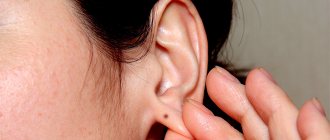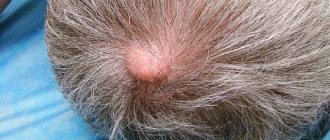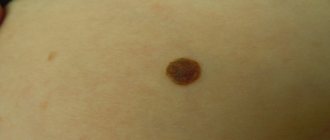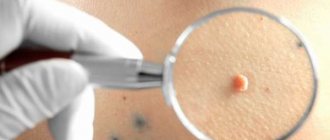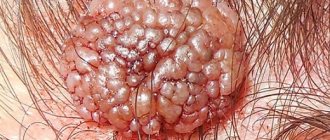Since ancient times, spots and growths on the skin have been given mystical meaning. Esotericists believe that these are marks of fate, symbolizing a gift or a curse. A mole on the head, the most visible part of the body, attracts increased attention to a person. If earlier it was considered the mark of the devil, now it is advised to properly care for the skin so as not to provoke a serious disease, because a damaged bulge triggers a chain of negative reactions of the body.
Moles in hair, what is the danger
Due to this location, a mole on the head (especially hidden in the hair) goes unnoticed for a long time. It is more susceptible to injury than other areas of the body. It can be damaged when wearing an uncomfortable headdress, when combing, cutting, styling and even washing your hair. Regular exposure of the birthmark to hair care products can cause irritation, swelling, and itching.
It is believed that not all moles have the ability to degenerate into a malignant tumor, but only a few under the influence of certain factors.
Localization value
Astrologers and fans of esotericism believe that any marks on the body indicate previous or future changes in fate and tell about the individual character of a person. To determine the value, the location of the spot, shape, color, and size are taken into account.
Nevus on the right side of the head. Promises success in a political career. The owner can achieve heights and climb the social ladder. Green or red color - signs of ministers, presidents.
Birthmark on the left temple. The person has a meek character. If the mark is on a man, then the head of his family will be his wife. She will control your life, ultimately destroy your reputation, and provoke a quarrel with friends. Perhaps life will be well-fed, rich, but without fame in high circles.
In the middle of the head (crown). The fly will give you enormous wealth. The personality is quite active, purposeful, with strong leadership abilities. You have your own view on any events; disputes are inappropriate.
Occipital zone, crown. It grows in people with opposite prejudices and a closed character. The bearer of the stain is gloomy, modest, and does not like to work.
The described characteristics are generalizations and are not always true.
Causes of moles
The mechanism of the appearance of birthmarks has not been fully studied, but it is known for sure that such formations are formed as a result of excess content of the melanin pigment.
Also, the appearance of moles is the result of uncontrolled cell division, which the immune system cannot cope with on its own.
There are also some additional factors that provoke the appearance of birthmarks:
- excessive sun exposure,
- frequent visits to the solarium,
- hormonal disorders,
- x-ray and radiation exposure,
- genetic predisposition,
- pathological changes in the functioning of internal organs and systems,
- skin aging,
- repeated injury to the epidermis.
Nevi can change throughout life: grow, change color, shape, sometimes disappear completely or appear in a new place. And it is important not to miss the appearance of dangerous signs of their degeneration into a malignant tumor.
What are the types of moles on the head?
Formations can be different in their structure, shape, and size. There are the following types of moles on the head:
- Large - is a congenital skin defect, has a brown color. It grows with a person and can reach significant sizes.
- Convex - a formation of red, brown or burgundy color that occurs in the inner layer of the skin and rises above it. Often the mole is covered with hairs. This type of mole appears in adulthood and there is a significant risk of damage.
- Flat is the most common type of birthmark on the head. It is located at the same level with the skin and does not cause discomfort to the owner of such a mark.
- Blue is very rare, but this does not mean that it is more dangerous than others. This formation is cone-shaped, bluish in color and protrudes slightly above the level of the epidermis.
- Hanging (in the form of a wart) are rarely found on the head. They are easily damaged and therefore require removal.
- A red - vascular mole is formed at birth; as the child grows older, it can disappear on its own.
Video
We offer you to watch a video on the topic of the article.
Education: Rostov State Medical University, specialty “General Medicine”.
Found an error in the text? Select it and press Ctrl + Enter.
In order to say even the shortest and simplest words, we use 72 muscles.
Dentists appeared relatively recently. Back in the 19th century, pulling out diseased teeth was the responsibility of an ordinary hairdresser.
In 5% of patients, the antidepressant Clomipramine causes orgasm.
Four pieces of dark chocolate contain about two hundred calories. So if you don’t want to gain weight, it’s better not to eat more than two slices a day.
Research shows that women who drink several glasses of beer or wine per week have an increased risk of developing breast cancer.
People who eat breakfast regularly are much less likely to be obese.
You are more likely to break your neck if you fall off a donkey than if you fall off a horse. Just don't try to refute this statement.
A job that a person doesn’t like is much more harmful to his psyche than no job at all.
Over the course of a lifetime, the average person produces no less than two large pools of saliva.
Human blood “runs” through the vessels under enormous pressure and, if their integrity is violated, it can shoot at a distance of up to 10 meters.
According to many scientists, vitamin complexes are practically useless for humans.
There are very interesting medical syndromes, for example, compulsive swallowing of objects. One patient suffering from this mania had 2,500 foreign objects in her stomach.
The well-known drug Viagra was originally developed for the treatment of arterial hypertension.
In an effort to get the patient out, doctors often go too far. For example, a certain Charles Jensen in the period from 1954 to 1994. survived more than 900 operations to remove tumors.
74-year-old Australian resident James Harrison has donated blood about 1,000 times. He has a rare blood type whose antibodies help newborns with severe anemia survive. Thus, the Australian saved about two million children.
The number of employees engaged in office work has increased significantly. This trend is especially true in large cities. Office work attracts men and women.
There is nothing unusual about moles on the body - such neoplasms appear in people at different years of life. But sometimes they appear on the head, and this is a little worse, because a mole on the head in the hair is not always noticeable, it can be accidentally damaged or it causes discomfort to its owner. Should I worry about a nevus located in such a place?
Differential diagnosis of a mole and skin cancer
All people with birthmarks should closely monitor them, especially those who have a family history of cancer. At the first suspicious symptoms, it is recommended to urgently visit a doctor, who, through diagnostic measures, will find out the cause of this transformation and determine the degree of danger to the person.
The appearance of a malignant tumor is the result of uncontrolled cell division.
To make a diagnosis confirming or refuting the nature of the tumor, a large number of techniques are used:
- visual examination of the mole and history taking,
- blood test - helps to identify a tumor marker characteristic of melanoma,
- dermatoscopy – allows, by magnifying the skin tenfold (using a dermatoscope), to examine not only the upper layer of the epidermis, but also the deeper layers of the skin,
- biopsy – to remove the affected tissue to determine the nature of the formation,
- ultrasound examination - allows you to assess the condition of the lymph nodes, measure the thickness of melanoma and determine the extent of its spread,
- computed tomography – helps to detect metastasis in various organs,
- magnetic resonance imaging – allows you to obtain images in transverse and longitudinal sections,
- radiothermometry – for early diagnosis of malignant tumors by measuring the temperature of internal tissues.
The most effective diagnostic method is positron emission tomography. It is carried out using a special radiopharmaceutical, which is introduced into the body and accumulates in the affected cells. When scanned, it appears as luminous spots.
A correct diagnosis allows you to more accurately select the necessary treatment method in each specific case.
Oncology
Moles need to be treated: when they cause concern, they begin to itch and change, perhaps they degenerate into melanoma.
In this case, the initial pigment spots are those that were found in a newborn, as well as wart-type moles. It is these two types that degenerate into cancer most often, in contrast to melanoform, melanocytic and papillomatous neoplasms.
Oncology manifests itself as follows:
- change in the shape and color of the pigment;
- a sharp increase;
- the presence of an ulcer.
If you have at least one of these symptoms, then you should go to a dermato-oncologist. The doctor will determine the degree of danger and the likelihood of developing into a cancerous tumor.
The causes of oncology development are:
- excessive exposure to the open sun without a hat;
- hereditary predisposition;
- diseases of the endocrine system.
Ultraviolet irradiation in a solarium leads to a sharp division of cells and disruption of their structure, which can provoke the degeneration of a benign neoplasm into oncology.
People at risk include fair-haired people, redheads, albinos, and those with white skin with many freckles.
Women should pay special attention to the condition of moles during pregnancy and menopause, as hormonal imbalance can lead to gene mutation
When does a tumor need to be removed?
Melanoma is the most dangerous and aggressive malignant tumor, which is formed as a result of the degeneration of melanocyte cells at the site of the mole. It progresses very quickly in the early stages of the disease with multiple metastases (in the lungs, brain, bones).
Once metastasis occurs, the disease is considered incurable and can cause death, so it is very important to closely monitor your moles in order to identify the approaching danger in time.
Signs to pay close attention to:
- a rapid increase in old or new marks begins (the size reaches more than 6 mm), while unevenness of the edges of the growth is observed,
- the color of the neoplasm changes (to darker or lighter),
- there is the presence of individual inclusions, crusts, cracks, scales,
- serous fluid is released or bleeding appears,
- there is an increase in lymph nodes,
- a feeling of soreness, burning and itching at the site of formation appears.
People at risk for moles turning into melanoma include:
- with fair skin with a lot of freckles and other growths,
- having increased sensitivity to solar radiation,
- working under the sun
- sunburned at any age,
- living in hot climates.
If the growth is removed at the initial stage of transformation into a malignant tumor, there is a significant chance of complete recovery.
Ways to combat nevi
The following methods for removing moles on the head are known:
- Laser therapy – removal of a birthmark using a high-precision laser beam. It destroys the cells of formation without leaving any traces.
- Cryodestruction - freezing the nevus using liquid nitrogen. A mole on the head becomes covered with a white crust, which subsequently falls off, leaving behind healthy skin.
- Radio wave therapy - using a radio wave knife, resembles surgical removal, only less traumatic for the head.
- Electrocoagulation is the cauterization of a growth on the head using a high-frequency current, which promotes its peeling and death.
If dangerous symptoms are observed and there is a suspicion that a mole on the head is turning into a malignant formation, immediate surgical intervention is necessary. It is performed by excision of the tumor and adjacent skin with a scalpel. The operation is dangerous due to bleeding and the formation of scars. In some cases, if the formation occupies a large area, skin grafting may be necessary.
Briefly about the main thing
If the mole is located on the head and the area of its contact with the skin does not exceed 15 mm, it can be removed quickly and with an excellent cosmetic result. Laser and radio wave surgery are the best options for this. These methods also make it possible to send the material for histological examination. If the area of contact with the skin is from 15 to 20 mm, a scalpel is best suited. If the area is 20 mm or more, skin grafting will most likely be required. In the hands of a skilled surgeon, even such operations are performed with good cosmetic results.
Sources:
- https://mjusli.ru/zhenskoe_zdorove/other/krasnaya-rodinka-na-golove
- https://beinusov.ru/info/rodinka-na-golove/
- https://junona.org/modules.php?name=Content&pa=showpage&pid=1128
- https://naturalworld.guru/article_astrologicheskie-znaki-tela-chto-oznachayut-rodinki-na.htm
- https://www.celt.ru/articles/art/art_27.phtml
Preventing skin cancer
To reduce the risk of melanoma, you must:
- avoid sun exposure to the skin, especially during peak sun activity,
- protect exposed areas of the body (if it is necessary to stay outside for a long time on sunny days),
- use sunscreen
- avoid visiting the solarium,
- comb and wash your hair with care,
- inspect moles daily, use the help of relatives or friends in hard-to-reach places,
- choose hats that do not cause squeezing and rubbing of moles,
- use non-aggressive hair care products,
- warn the hairdresser about a mole on the head when visiting a beauty salon.
Under no circumstances should you remove the tumor yourself - this will lead to irreversible consequences.
The main protection against an incurable disease is early consultation with a doctor if negative signs appear.
It should be remembered that melanoma can be defeated only with timely treatment.


